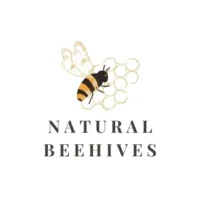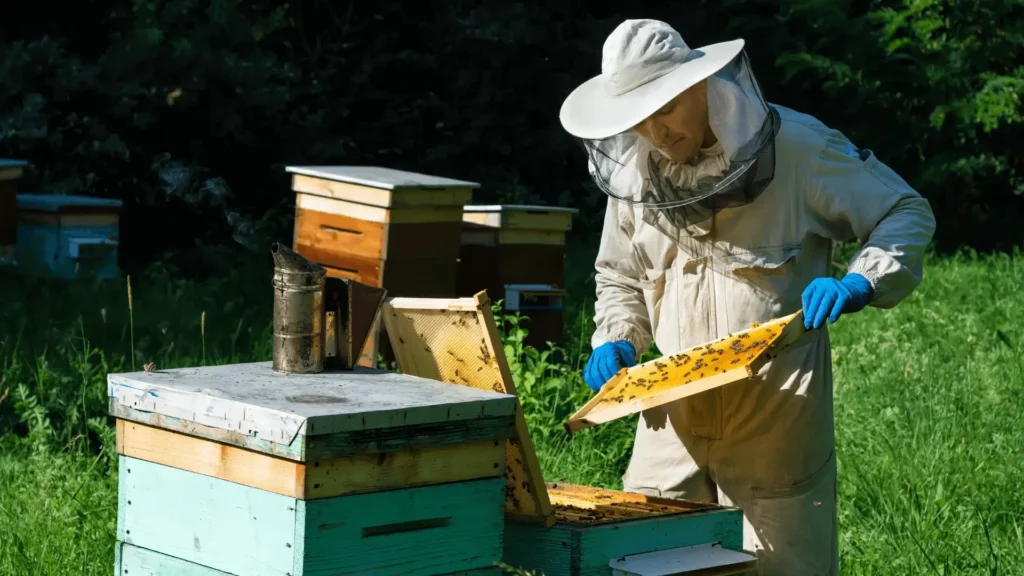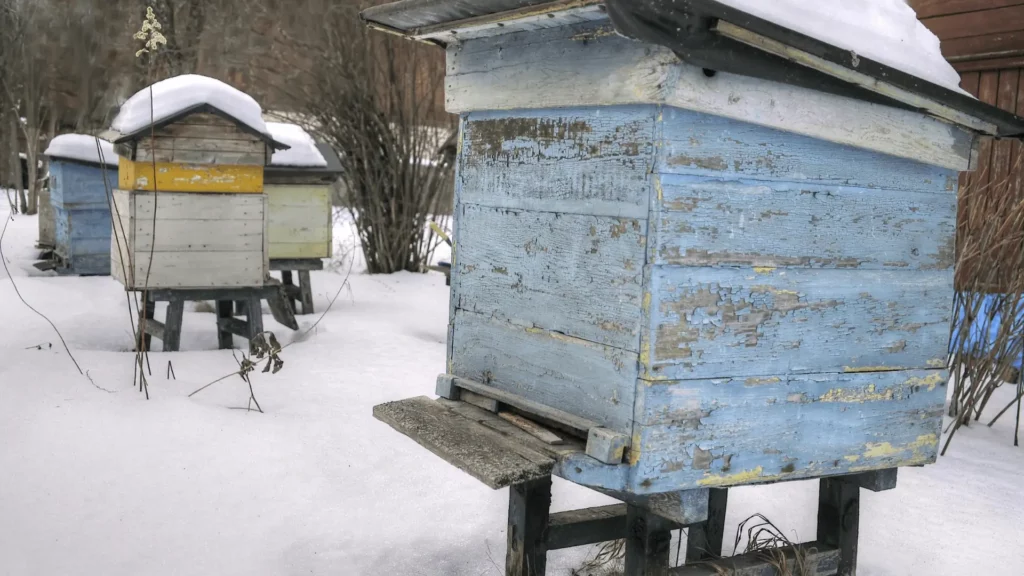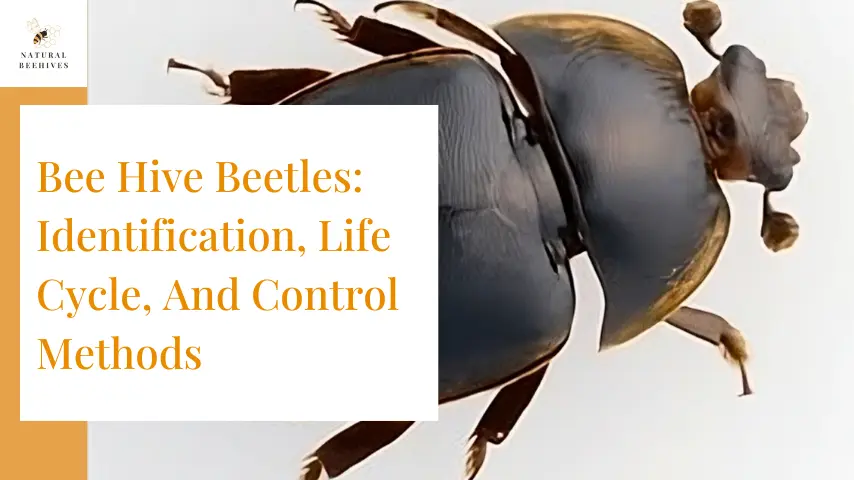
Small Bee Hive also known as Small Hive Beetles (SHB), are a significant threat to beekeepers worldwide. These tiny pests, scientifically known as Aethina tumida, are opportunistic scavengers that feed on honey, pollen, and bee brood within the hive. They can quickly multiply and overwhelm a colony, leading to its decline or even collapse if appropriate control measures are not implemented promptly.
In fact, studies have shown that a single female SHB can lay up to 2,000 eggs in a single hive, exacerbating the infestation rapidly. Such high reproductive rates contribute to the devastating impact SHB infestations can have on bee colonies, making it crucial for beekeepers to stay vigilant and proactive in managing and preventing these outbreaks.
Small Hive Beetles (SHB) pose a serious threat not only to individual bee colonies but also to the overall health of bee populations globally. The presence of these invasive pests can weaken the immune systems of bees, making them more susceptible to diseases and other stressors. Moreover, SHB infestations can cause honey production to decrease significantly, impacting both beekeepers and agricultural ecosystems that rely on bees for pollination.
To effectively combat the spread of Small Hive Beetles, beekeepers must employ a combination of preventative measures and control strategies. One key approach is to maintain strong and healthy bee colonies through regular hive inspections and monitoring for early signs of SHB presence. Keeping hives clean and well-maintained can also help deter these pests from establishing a foothold and reproducing rapidly.
In addition to good hive management practices, beekeepers can use various control methods to mitigate SHB infestations. These can include setting up beetle traps within the hive, using beneficial nematodes to target SHB larvae in the soil surrounding the hive, and implementing non-toxic repellents to keep the beetles at bay. It is crucial for beekeepers to educate themselves about the lifecycle and behavior of Small Hive Beetles to develop effective control strategies tailored to their specific needs and circumstances.
By staying informed, proactive, and vigilant, beekeepers can help protect their bee colonies from the destructive impact of Small Hive Beetles and contribute to the long-term health and sustainability of bee populations worldwide.
Origin and Distribution
Small hive beetles originally hail from sub-Saharan Africa. In their native habitat, they’re more of a nuisance than a major threat. African honey bees have developed strategies to deal with these pests over time.
However, when SHB traveled to other parts of the world, they became an invasive pest of bee hives. They’ve spread to North America, Australia, and parts of Europe and Asia.
It’s like introducing a new predator to an ecosystem that’s never encountered it before. The local honey bees simply aren’t prepared to deal with this new threat.
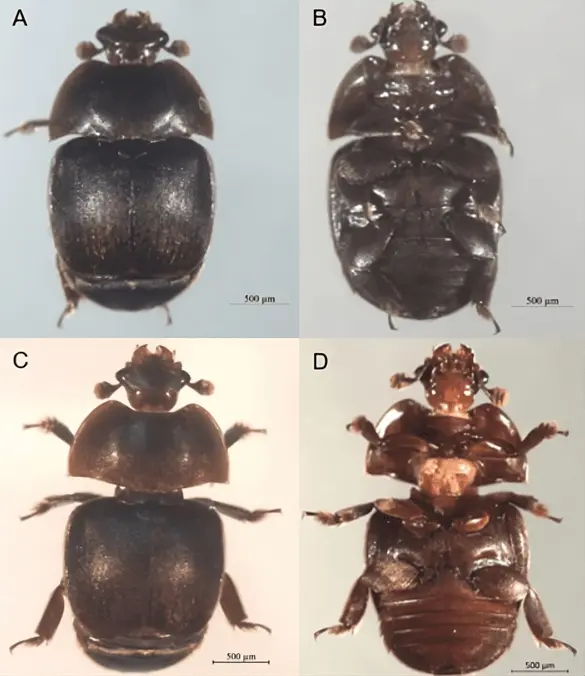
Image credit: Francisco Posada
Life Cycle of Small Hive Beetles
Understanding the life cycle of SHB is crucial for effective management. It all starts with a tiny egg, barely visible to the naked eye. Female beetles lay these eggs in cracks and crevices within the hive.
Within 2-3 days, these eggs hatch into small hive beetle larvae. These grubs are the most destructive stage of the beetle’s life cycle. They feed voraciously on everything in the hive – honey, pollen, and even bee brood.
After about 10-14 days of feeding, the larvae leave the hive to pupate in the soil. This stage lasts around 3-4 weeks, depending on soil temperature and moisture.
Finally, adult beetles emerge from the soil and fly back to infest bee colonies, starting the cycle anew.
Think of it like a destructive relay race, with each stage passing the baton of destruction to the next.
Small Hive Beetles are invasive pests originating from Africa, with a life cycle that includes egg, larval, pupal, and adult stages, each posing unique threats to honey bee colonies.
Identifying Small Bee Hive Beetles
Spotting Small Hive Beetles early can make all the difference in protecting your hives. But how do you identify these tiny troublemakers?
First, let’s talk about size. Adult SHBs are small – about 5-7 mm long and 3-4.5 mm wide. That’s roughly the size of a grain of rice. Their small size makes them easy to miss if you’re not looking carefully.
Color is another key identifier. Adult beetles are dark brown to black, with a glossy appearance. They might remind you of a miniature, oval-shaped tank rolling through your hive.
Appearance of Adult Beetles
Adult hive beetles have a distinct appearance. Their bodies are oval-shaped and flattened, perfect for squeezing into tight spaces in the hive.
One unique feature is their clubbed antennae. Imagine tiny drumsticks on their heads – that’s what their antennae look like.
Their legs are also noteworthy. SHBs have spines on their legs that help them cling to surfaces. This adaptation allows them to resist being removed by bees trying to clean the hive.
Remember, a small hive beetle adult might be easily confused with other small beetles. Always double-check before taking action.
Recognizing Larvae and Eggs
SHB larvae look quite different from adults. They’re creamy white and about 1 cm long when fully grown.
Think of them as tiny, pale caterpillars with rows of spines along their backs. These spines give them a slightly bristly appearance.
As for eggs, they’re tiny – about 1.4 mm long. They’re pearly white and oval-shaped, often laid in clusters in cracks and crevices of the hive.
Spotting eggs or larvae is a clear sign of a beetle population in your hive. If you see these, it’s time to take action to control the small hive beetle population.
How Many Hive Beetles is Too Many?
While seeing a few small hive beetles in your hive may not immediately spell disaster, it’s essential to keep their population in check. The threshold for “too many” hive beetles varies depending on the size and strength of your honey bee colony.
As a general guideline, if you notice more than a handful of adult beetles scurrying around the hive or detect signs of larval activity such as slimy residues or damaged comb, it’s time to take action. Prevention and early intervention are key to protecting your bees from the destructive effects of small hive beetles.
Identifying Small Hive Beetles involves recognizing their small size, dark coloration, and unique features like clubbed antennae in adults, while larvae appear as creamy white, bristly grubs.
RELATED: Bee Nest Types: Unraveling the Fascinating Diversity of Bee Homes
Damage Caused by Small Hive Beetles
The destruction caused by Small Hive Beetles can be devastating to a honey bee colony. These tiny invaders can quickly turn a thriving hive into a slimy, fermented mess.
Imagine coming home to find your pantry overrun with pests, your food spoiled, and your house in chaos. That’s essentially what SHBs do to a beehive.
The greatest amount of SHB damage comes from the larvae. These voracious grubs feed on everything in the hive – honey, pollen, and even bee brood. As they feed, they defecate in the honey, causing it to ferment and run out of the comb.
This process, known as “sliming out,” can happen rapidly, especially in weak colonies. Within just a few days, a heavily infested hive can become a slimy, stinking mess that bees will abandon.
Impact on Honey and Brood Combs
The damage to honey and brood combs is particularly severe. As larvae tunnel through the comb, they destroy its structure. This not only ruins the honey crop but also disrupts the bees’ ability to raise new bees.
Picture a beautifully constructed honeycomb, each cell a perfect hexagon filled with golden honey or developing bee brood. Now imagine that comb riddled with tunnels, the honey oozing out, and the brood dying or already consumed.
The live honey bee brood is particularly vulnerable. SHB larvae will feed directly on bee eggs and developing larvae, dramatically reducing the colony’s ability to replenish its population.
Even if the colony survives the initial infestation, the damage to the wax comb can take a long time to repair. This puts additional stress on the colony, making it more susceptible to other threats like varroa mites or diseases.
Small Hive Beetles cause extensive damage to beehives by consuming honey, pollen, and brood, leading to fermentation of honey and destruction of combs, which can ultimately result in colony collapse.
Detection Methods for Small Hive Beetles
Early detection of a hive beetle infestation is crucial for effective management. But how do you spot these tiny invaders before they cause major damage?
Visual inspection is your first line of defense. During routine hive checks, keep an eye out for adult beetles scurrying across the frames or hiding in cracks and crevices. They’re fast runners and will quickly seek shelter when exposed to light.
Look for signs of larvae too. Check the bottom board for crawling grubs, especially if you notice fermented honey odors or see honey oozing from cells.
Another effective detection method is using traps. There are various types available, from corrugated plastic strips to oil traps. These can help you monitor beetle populations and catch them before they reproduce.
Consider using flashlights during inspections. SHBs tend to flee from light, making them easier to spot as they run.
Don’t forget to check stored equipment too. SHBs can infest stored combs and supers, ready to invade active hives when given the chance.
Remember, regular inspections are key. The sooner you detect an infestation, the easier it is to control. Make SHB checks a part of your routine hive maintenance, just like checking for queen cells or assessing honey stores.
Detecting Small Hive Beetles involves regular visual inspections, use of traps, and careful monitoring of hive conditions, with early detection being crucial for effective control.
Prevention Strategies
When it comes to Small Hive Beetles, prevention is definitely better than cure. Let’s explore some effective preventive measures to keep these pests at bay.
Maintaining Strong Colonies
A strong colony is your best defense against SHB. Think of it as a well-guarded fortress – the more bees you have, the better they can patrol and protect their home.
Ensure your colonies have healthy, productive queens. Regularly replace old queens to maintain vigorous egg-laying.
Provide adequate nutrition, especially during dearth periods. Well-fed bees are better equipped to fight off invaders.
Avoid overharvesting honey. Leave enough for the bees to maintain their strength.
Remember, a strong hive isn’t just about numbers. It’s about having a balanced population of workers, with enough bees to cover and protect all areas of the hive.
Proper Hive Placement and Management
Where and how you place your hives can significantly impact SHB populations. Here are some tips:
1. Choose sunny locations: SHBs prefer moist, shady areas. Placing hives in full sun can discourage beetle activity.
2. Use solid bottom boards: These provide fewer hiding places for beetles compared to screened bottoms.
3. Keep hives off the ground: Elevating hives makes it harder for beetle larvae to reach the soil for pupation.
4. Maintain clean apiaries: Remove debris and keep grass short around hives. This reduces hiding spots for beetles.
5. Manage hive size: Use only as many boxes as the bees can occupy. Extra space gives beetles room to hide.
In colder climates, SHBs are less of a problem. They can’t survive cold winters outdoors. However, they can overwinter inside heated buildings, so be cautious with indoor storage of equipment.
Regular hive inspections are crucial. Catch any signs of weakness or pest issues early, before they become major problems.
Preventing Small Hive Beetle infestations relies on maintaining strong colonies, strategic hive placement, and proper apiary management to create an environment unfavorable for beetle reproduction and survival.
RELATED: Master Beehive Splitting: 13 Essential Steps for Beekeepers
Control Measures for Small Hive Beetles
Despite our best prevention efforts, sometimes Small Hive Beetles still manage to invade. When this happens, it’s time to deploy effective control measures. Let’s explore some of the best treatments available.
Mechanical Traps
Mechanical traps are a popular and chemical-free method to control SHB. There are numerous mechanical trap designs available, each with its own advantages.
One common type is the Beetle Blaster. This plastic trap fits between frame tops and contains mineral oil or vegetable oil. Beetles enter and drown in the oil.
Another effective option is using Swiffer sheets or Brawny towels. Place these under the inner cover. Beetles get trapped in the fibers as they try to hide from the bees.
Some beekeepers swear by CD cases filled with mineral oil and boric acid. The narrow opening allows beetles in but keeps bees out.
Remember, no single trap will eliminate all beetles. Use a combination of methods for best results. And always check and clean traps regularly to maintain their effectiveness.
Chemical Treatments
While mechanical traps are often preferred, sometimes chemical treatments are necessary, especially for severe infestations.
One EPA-approved treatment is CheckMite+ strips (coumaphos). These are placed in the hive for a specific period to kill adult beetles. However, use caution as overuse can lead to resistant beetles and harm bees.
Some beekeepers use Gardstar (permethrin) to treat the soil around hives, targeting pupating larvae. Apply it carefully to avoid contaminating the hive or harming bees.
A newer option is the use of hive beetle repellents. These products aim to drive beetles out of the hive rather than killing them directly.
Remember, chemical treatments should be a last resort. They can leave residues in honey and wax, and overuse can lead to resistance. Always follow label instructions carefully and consider the potential impacts on your bees and honey production.
Natural Control Methods
For those preferring a more natural approach, several options exist:
Diatomaceous earth (DE) is a popular choice. This fine powder damages the exoskeletons of beetles and larvae. Sprinkle it on the ground around hives or use DE products designed for in-hive use.
Nematodes can be effective against pupating larvae in the soil. These microscopic worms parasitize the beetles, disrupting their life cycle.
Some beekeepers report success with essential oils like peppermint or tea tree. These may repel beetles when used in small amounts inside the hive.
Beneficial fungi, like Metarhizium anisopliae, can be applied to soil to target pupating larvae.
Remember, while these methods are natural, they’re not without risks. Use DE carefully to avoid harming bees, and always research potential impacts before introducing new substances to your hives.
Controlling Small Hive Beetles involves a multi-faceted approach, including mechanical traps, judicious use of chemical treatments when necessary, and natural methods like diatomaceous earth, each with their own benefits and considerations.
The video showcases new small hive beetle control inventions presented by Dr. Lewis J Bartlett from the University of Georgia:
Advanced Management Techniques
As you become more experienced in dealing with Small Hive Beetles, you might want to explore some advanced management techniques. These methods can provide additional layers of protection for your hives.
Using Screened Bottom Boards
Screened bottom boards can be a valuable tool in your SHB management arsenal. They allow beetles to fall through but prevent them from climbing back up.
Place an oil pan or sticky board beneath the screen to trap fallen beetles. Some beekeepers use a mixture of vegetable oil and dish soap in these traps.
The added ventilation from screened bottoms can also help keep the hive environment less favorable for beetles.
Remember, while effective, screened bottoms alone won’t solve a beetle problem. They work best as part of a comprehensive management strategy, combined with other methods like regular hive inspections and maintaining strong colonies.
Freezing Infested Equipment
Freezing is an excellent way to deal with infested equipment without using chemicals. It’s particularly useful for stored combs or honey supers.
Place infested equipment in a freezer for at least 48 hours. This will kill all life stages of the beetle – eggs, larvae, and adults.
After freezing, clean the equipment thoroughly before reusing. Remove any dead beetles or larvae to prevent attracting more pests.
For those interested in diving deeper into SHB management techniques, many beekeeping associations offer detailed guides. A quick online search for “PDF of Small Hive Beetle management” can provide comprehensive resources tailored to your specific region.
Advanced SHB management techniques like using screened bottom boards and freezing infested equipment provide additional, chemical-free methods to control beetle populations and protect hive resources.
RELATED: Revolutionize Bee Feeding: 7 Reasons Why the Bucket Bee Raft Is a Game-Changer for Beekeepers
Comparing Small Hive Beetles to Other Pests
While Small Hive Beetles are a significant concern, they’re not the only pest beekeepers need to worry about. Let’s briefly compare SHB to another common hive pest: the Varroa mite.
Varroa mites are tiny arachnids that feed on bee hemolymph (blood). Unlike SHB, which primarily damage hive resources, Varroa directly harm the bees themselves.
SHB are visible to the naked eye, while Varroa mites are barely visible. This makes SHB easier to detect during routine inspections.
Both pests can lead to colony collapse if left unchecked. However, Varroa mites are generally considered more devastating due to their direct impact on bee health and their role in transmitting viruses.
Control methods differ too. While traps work well for SHB, Varroa management often involves chemical treatments or biotechnical methods like drone brood removal.
Understanding these differences helps beekeepers develop comprehensive pest management strategies that address multiple threats simultaneously.
While both Small Hive Beetles and Varroa mites pose significant threats to bee colonies, they differ in their impact, detection methods, and control strategies, necessitating tailored approaches for effective management.
Legal Considerations and Reporting Requirements
In many areas, Small Hive Beetles are considered a reportable pest. This means if you detect them in your hives, you’re legally required to notify local agricultural authorities.
These reporting requirements help track the spread of SHB and can alert other beekeepers in the area to potential threats.
Some regions are known hotbeds of Small Hive Beetle activity. If you’re in one of these areas, you might face additional regulations or inspections.
Always check your local and state regulations regarding SHB. Compliance not only helps control the spread of this pest but also protects you legally as a beekeeper.
Beekeepers must be aware of and comply with local legal requirements for reporting Small Hive Beetle infestations, which aids in tracking and controlling the spread of this pest.
RELATED: Bee Swarm vs. Supersedure Cells: Master Queen Cell Management in Your Beehive [Expert Guide]
Conclusion
As beekeepers, protecting our hives from Small Hive Beetles is crucial for maintaining strong, healthy colonies. By implementing the ten essential strategies outlined in this guide, you’re well-equipped to detect, prevent, and manage these persistent pests effectively. Remember, a strong colony is your best defense against Small Hive Beetles.
Regular hive inspections, proper placement, and maintaining good hygiene are key preventive measures. Utilize mechanical traps, consider chemical treatments when necessary, and explore natural control methods like diatomaceous earth. Don’t forget to implement advanced techniques such as screened bottom boards and freezing infested equipment.
Stay vigilant, adapt these strategies to your specific situation, and always prioritize the health of your honey bee colonies. With dedication and the right approach, you can successfully protect your hives from Bee Hive Beetles and ensure a thriving apiary. Happy beekeeping, and may your colonies remain strong and productive!
